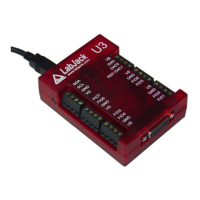None of the Get functions will clear results from the list. The first AddRequest() call subsequen
to a Go call will clear the internal lists of requests and results for a particular device.
When processing raw in/out or stream data requests, the call to a Get function does not a
cause the
t
ctually
data arrays to be filled. The arrays are filled during the Go call (if data is available),
nd the Get call is used to find out many elements were placed in the array.
ersion of the Get function where IOType is a string rather than a long.
his is useful for passing string constants in languages that cannot include the header file, and
IOTypes except put/get config. The string should contain the constant
NALOG_INPUT”). The declaration for the
n of Get is the same as below except for (…, const char *pIOType, …).
SS() is a special version of the Get function where IOType and Channel are strings
rather than longs. This is useful for passing string constants in languages that cannot include
e header file, and is generally only used with the put/get config IOTypes. The strings should
ontain the constant name as indicated in the header file (such as “LJ_ioPUT_CONFIG” and
“LJ_chLOCALID”). The declaration for the SS version of Get is the same as below except for
Type, const char *pChannel, …).
a
GetResultS() is a special v
T
is generally used with all
name as indicated in the header file (such as “LJ_ioA
S versio
GetResult
th
c
(…, const char *pIO
It is acceptable to pass NULL (or 0) for any pointer that is not required.
Declaration:
J_ERR
L OR _stdcall GetResult ( LJ_HANDLE Handle,
long IOType,
long Channel,
double *pValue)
arameter Description:
P
pValue – A pointer to the result value.
lt() and GetNextResult()
her G matches the list of requests. Use
Result() and GetNextResult() to step through the list of results in order. When either
function re n re no more items in the list of
ems can be read more than once by calling GetFirstResult() to move back to the
beginning
UserData is provided for tracking information, or whatever else the user might need.
ent to a
he arrays are filled during the Go call (if data is available),
nd the Get call is used to find out many elements were placed in the array.
Returns: LabJack errorcodes or 0 for no error.
Inputs:
• Handle – Handle returned by OpenLabJack().
• IOType – The type of request. See Section 4.3.
• Channel – The channel number of the particular IOType.
utputs:
O
•
4.2.9 GetFirstResu
Calling eit o function creates a list of results that
GetFirst
tur s LJE_NO_MORE_DATA_AVAILABLE, there a
results. It
of the list.
None of the Get functions clear results from the list. The first AddRequest() call subsequ
Go call will clear the internal lists of requests and results for a particular device.
When processing raw in/out or stream data requests, the call to a Get function does not actually
ause the data arrays to be filled. T
c
a
54

